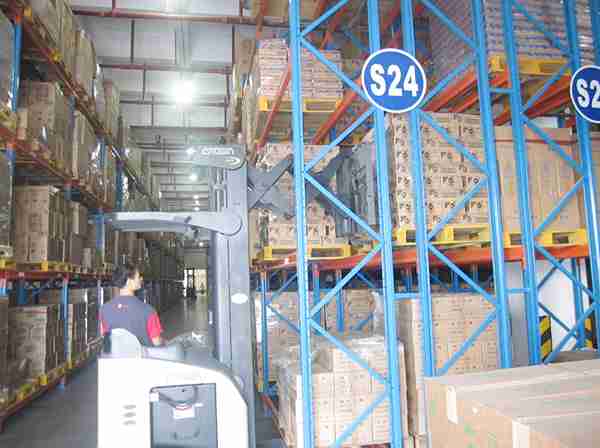📐 "First 50 Enterprise Queries Get Custom 3D Warehouse Design" Plan

Introduction: Revolutionizing Retail Warehousing with Double Deep Racking
In the competitive world of retail logistics, warehouse efficiency is everything. Double deep racking for retail warehouses has emerged as a game-changing solution, allowing businesses to store more inventory in the same space while maintaining operational agility.
This in-depth guide explores how double deep racking for retail warehouses can maximize storage density, reduce costs, and streamline order fulfillment. Whether you’re managing a small distribution center or a large-scale retail warehouse, understanding the strategic advantages of double deep racking for retail warehouses will help you optimize space, improve workflows, and boost profitability.

H1: What Is Double Deep Racking for Retail Warehouses?
H2: The Fundamentals of Double Deep Racking
Double deep racking for retail warehouses is a high-density storage system where pallets are stored two rows deep instead of one. Unlike traditional selective racking, which provides direct access to every pallet, double deep racking for retail warehouses requires specialized reach trucks or forklifts to retrieve pallets from the second row.
H2: How It Works in Retail Warehousing
- Two-deep pallet storage minimizes aisle space.
- Requires narrow-aisle forklifts (NA) or double-reach trucks.
- Ideal for retail warehouses with medium-to-low turnover SKUs.
H1: Why Retail Warehouses Need Double Deep Racking
H2: 1. Unmatched Space Utilization
Double deep racking for retail warehouses doubles storage capacity without expanding the facility. This is crucial for urban retail warehouses where real estate costs are high.
H2: 2. Cost Efficiency & ROI
- Reduces need for additional warehouse space.
- Lowers storage costs per pallet compared to single-deep systems.
H2: 3. Enhanced Inventory Control
- Perfect for retail warehouses storing bulk seasonal items.
- Reduces clutter and misplaced inventory.
H2: 4. Faster Order Fulfillment
- Optimized pallet retrieval with trained operators.
- Can integrate with automated warehouse systems (AS/RS).
H1: Comparing Double Deep Racking to Other Retail Warehouse Solutions
H2: Double Deep vs. Selective Racking for Retail Warehouses
| Feature | Double Deep Racking | Selective Racking |
|---|---|---|
| Storage Density | High (2-deep) | Low (1-deep) |
| Accessibility | Requires reach truck | Direct access |
| Best For | Bulk storage, seasonal goods | Fast-moving SKUs |
H2: Double Deep vs. Drive-In Racking for Retail Warehouses
- Drive-in racking allows deeper storage but lacks selectivity.
- Double deep racking for retail warehouses offers better accessibility for medium-turnover goods.
H2: Double Deep vs. Push-Back Racking for Retail Warehouses
- Push-back racking uses LIFO (Last-In, First-Out).
- Double deep racking for retail warehouses can support FIFO (First-In, First-Out) with proper planning.
H1: Best Practices for Implementing Double Deep Racking in Retail Warehouses
H2: 1. Warehouse Layout & Aisle Optimization
- Narrow aisles (8-10 feet) maximize space.
- Cross-aisles improve forklift navigation.
H2: 2. Choosing the Right Equipment
- Double-reach forklifts are essential.
- Narrow-aisle (NA) forklifts enhance maneuverability.
H2: 3. Smart Inventory Slotting
- Fast-moving SKUs in the front row.
- Slow-moving stock in the back.
H2: 4. Safety & Maintenance
- Regular rack inspections prevent accidents.
- Impact-resistant racking reduces damage risks.
H1: Overcoming Challenges in Double Deep Racking for Retail Warehouses
H2: 1. Limited Accessibility
- Solution: Use WMS (Warehouse Management Software) for real-time tracking.
H2: 2. Higher Forklift Skill Requirements
- Solution: Invest in certified operator training.
H2: 3. Potential for Pallet Damage
- Solution: Use reinforced pallets and protective rack guards.
H1: Real-World Success: Retail Warehouse Case Study
A major U.S. retail chain implemented double deep racking for retail warehouses and saw:
✅ 40% increase in storage capacity
✅ 20% reduction in operational costs
✅ Faster order processing times
H1: The Future of Double Deep Racking in Retail Warehousing
- AI-powered slotting for optimal pallet placement.
- Automated retrieval systems for faster operations.
Conclusion: Is Double Deep Racking the Right Choice for Your Retail Warehouse?
If your retail warehouse struggles with space constraints, high storage costs, or inefficient workflows, double deep racking for retail warehouses could be the perfect solution. By following best practices in layout design, equipment selection, and inventory management, you can transform your warehouse into a high-efficiency storage hub.
For more insights, explore our guides on selective racking and automated warehouse systems.
FAQs About Double Deep Racking for Retail Warehouses
1. What’s the ideal aisle width for double deep racking in retail warehouses?
8-10 feet is optimal for narrow-aisle forklifts.
2. Can double deep racking support FIFO inventory in retail warehouses?
Yes, with proper pallet rotation and WMS tracking.
3. How much can a retail warehouse save by switching to double deep racking?
Up to 30% in storage costs compared to single-deep systems.
4. Is double deep racking suitable for cold storage retail warehouses?
Yes, but forklifts must be cold-rated and racking must resist corrosion.
5. What’s the average ROI for implementing double deep racking in retail warehouses?
Most businesses see ROI within 12-18 months due to space savings and efficiency gains.
By leveraging double deep racking for retail warehouses, businesses can maximize storage, cut costs, and improve logistics performance—making it a must-have solution for modern retail warehousing.




